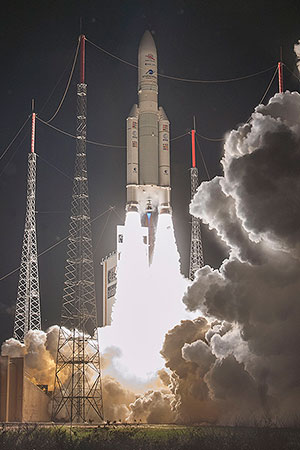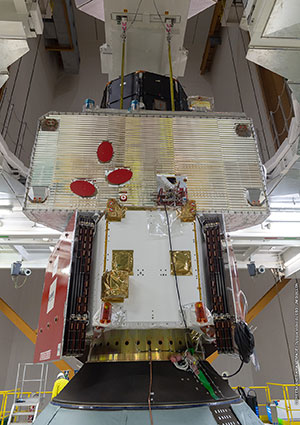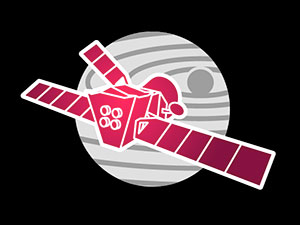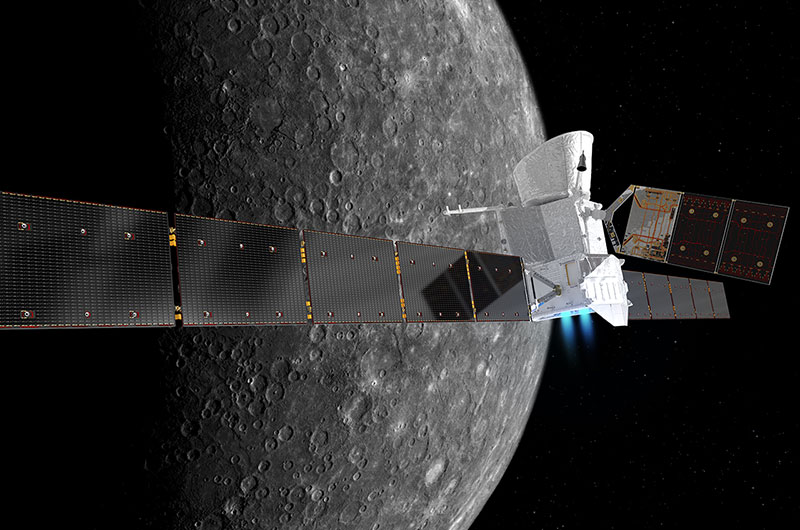 advertisements advertisements
|

|
BepiColombo launches on ESA and JAXA mission to planet Mercury
October 19, 2018 — For only the third time in history, a mission is now on its way to study the innermost planet of our solar system.
The European Space Agency (ESA) and Japan Aerospace Exploration Agency's (JAXA) joint BepiColombo mission launched on a seven-year journey to orbit the planet Mercury on Friday (Oct. 19). The mission's dual spacecraft, ESA's Mercury Planetary Orbiter (MPO) and JAXA's Mercury Magnetospheric Orbiter (MMO), along with the ESA-built Mercury Transfer Module (MTM), lifted off at 9:45 p.m. EDT (10:45 p.m. local time or 0145 GMT Oct. 20) from Ariane Launch Complex 3 (ELA-3) at Guiana Space Center, Europe's spaceport in Kourou, French Guiana.
"It is just the beginning of the trip, but it is already a great day," said Jan Wörner, ESA Director General. "Launching BepiColombo is a huge milestone for ESA and JAXA, and there will be many great successes to come."
"JAXA has high expectations that the ensuing detailed observations on the surface and interior of Mercury will help us better understand the environment of the planet, and ultimately, the origin of the solar system, including that of Earth," said Hiroshi Yamakawa, JAXA President.
Europe's and Japan's first mission to Mercury, following two prior U.S. missions, BepiColombo is the first mission to Mercury to send two spacecraft to make complementary measurements of the planet's environment at the same time. The mission is named after the 20th-century Italian mathematician and engineer Giuseppe "Bepi" Colombo, who explained Mercury's rotation rate and calculated the trajectories that enabled the first flybys of the planet by NASA's Mariner 10 probe in the mid-1970s.
Over the next seven years and 5.6 billion miles (9 billion kilometers), BepiColombo will use solar electric propulsion and gravity-assist planetary flybys to arrive in orbit around Mercury in December 2025. The mission will make one flyby of Earth in April 2020, two at Venus in October 2020 and August 2021, and will fly by Mercury six times between October 2021 and January 2025.
During the voyage to Mercury, the two orbiters and the transfer module will form one single composite spacecraft. The MPO and MMO orbiters though, will be able to operate some of their science instruments during the cruise phase, providing opportunities to also collect data at Venus.
Once in orbit around Mercury, the two BepiColombo spacecraft will build on the discoveries and questions raised by NASA's MESSENGER mission, which circled the planet between 2011 and 2015. ESA's MPO and JAXA's MMO (which is also known as "Mio," Japanese for waterway or fairway) will provide further insight into how planets close to their stars evolve.
Operating so close to the Sun — the solar intensity at Mercury is about 10 times that at Earth — required developing new technologies and materials, including high-temperature coatings, multi-layered insulation and a radiator for MPO. MMO will spin 15 times per minute to avoid overheating (during the cruise phase, when it is not able to spin, MMO will be protected by a sunshield).
When approaching Mercury in late 2025, the transfer module will separate and the composite spacecraft will use rocket engines and a technique referred to as "weak stability boundary capture" to bring it into polar orbit around the planet. When the MMO orbit is reached, the MPO will separate and lower its altitude to its own orbit.
Beginning in March 2026, BepiColombo will collect data to form a complete map of Mercury at different wavelengths. The ESA and JAXA probes will chart the planet's mineralogy and elemental composition, determine whether the interior of the planet is molten or not, and investigate the extent and origin of Mercury's magnetic field.
"A unique aspect of this mission is having two spacecraft monitoring the planet from two different locations at the same time: this is really key to understanding processes linked to the impact of the solar wind on Mercury's surface and its magnetic environment," said Johannes Benkhoff, ESA's BepiColombo project scientist.
"BepiColombo will build on the discoveries and questions raised by NASA's MESSENGER mission to provide the best understanding of Mercury and solar system evolution to date, which in turn will be essential for understanding how planets orbiting close to their stars in exoplanet systems form and evolve, too," Benkhoff said.
Observations from Mercury orbit will continue for at least one Earth year with the possibility of an extension. Mercury turns on its axis once every 58 Earth days and orbits the Sun once every 88 Earth days.
Prior to BepiColombo, only NASA's Mariner 10 and MESSENGER spacecraft visited Mercury. Mariner 10 provided the first-ever close-up images of the planet when it flew past Mercury three times in 1974 and 1975. En route to its final destination in orbit around Mercury in 2011, MESSENGER flew past the planet three times, providing new data and images.
A European mission to Mercury was first proposed in 1993. In February 2007, the BepiColombo mission was approved as part of ESA's Cosmic Vision program. Following an unavoidable increase in the mission's mass during 2008, the launch vehicle was changed from Russia's Soyuz-Fregat rocket to the Ariane 5.
BepiColombo is the 51st mission to be performed by Arianespace (with the 73rd satellite) for ESA and the 23rd mission at the service of deep space exploration. |
|

ESA's and JAXA's BepiColombo mission to Mercury launches atop an Arianespace Ariane 5 rocket on Oct. 19, 2018, from the Guiana Space Center in French Guiana. (ESA-CNES/Arianespace)

The BepiColombo spacecraft, comprising ESA's Mercury Planetary Orbiter (MPO), JAXA's Mercury Magnetospheric Orbiter (MMO) and the ESA-built Mercury Transfer Module, is mounted atop its Ariane 5 launcher on Oct. 11 in French Guiana. (ESA/CNES/Arianespace)

BepiColombo mission logo. (ESA) |

Artist's impression of the BepiColombo spacecraft in cruise configuration, with Mercury in the background. The ESA-built Mercury Transfer Module is shown with ion thrusters firing, and with its solar wings extended. The solar array of ESA's Mercury Planetary Orbiter in the middle is seen extending to the top. JAXA's Mercury Magnetospheric Orbiter is hidden inside the sunshield in this orientation. (ESA/ATG/NASA) |
|

© collectSPACE. All rights reserved.
|
|

|

|
